Potřebujeme váš souhlas k využití jednotlivých dat, aby se vám mimo jiné mohly ukazovat informace týkající se vašich zájmů. Souhlas udělíte kliknutím na tlačítko „OK“.
ASTM F2694-07(2013)
Standard Practice for Functional and Wear Evaluation of Motion-Preserving Lumbar Total Facet Prostheses
Automaticky přeložený název:
Standardní praxe pro funkční a opotřebení Hodnocení Motion-zachování bederní Celkem fazetových Protézy
NORMA vydána dne 1.3.2013
Informace o normě:
Označení normy: ASTM F2694-07(2013)
Poznámka: NEPLATNÁ
Datum vydání normy: 1.3.2013
Kód zboží: NS-54386
Počet stran: 9
Přibližná hmotnost: 27 g (0.06 liber)
Země: Americká technická norma
Kategorie: Technické normy ASTM
Kategorie - podobné normy:
Anotace textu normy ASTM F2694-07(2013) :
Keywords:
dynamic test, facet arthroplasty, posterior instrumentation, spinal implants, static test, wear assessment, weight loss method, ICS Number Code 11.040.40 (Implants for surgery, prothetics and orthotics)
Doplňující informace
| Significance and Use | ||||||||||
|
5.1 Total Facet Prosthesis Components—The total facet replacement may comprise a variety of shapes and configurations. Its forms may include, but are not limited to, ball and socket articulating joints, joints having a free-floating or semi-constrained third body, metallic load-bearing surfaces, and spring and dampening mechanisms. Additionally, it may be a unilateral or bilateral design. 5.2 Spinal Testing Apparatus: 5.2.1 Test Chambers—In case of a multispecimen machine, each chamber shall be isolated to prevent cross-contamination of the test specimens. The chamber shall be made entirely of corrosion resistant materials, such as acrylic plastic or stainless steel, and shall be removable from the machine for thorough cleaning between tests. 5.2.2 Component Clamping/Fixturing—Since the purpose of the test is to characterize the wear and kinematic function of the total facet prosthesis, the method for mounting components in the test chamber shall not compromise the accuracy of assessment of the weight loss or stiffness variation during the test. For example, prostheses having complicated superior and inferior surfaces for contacting bone (for example, sintered beads, hydroxylapatite (HA) coating, plasma spray) may be specially manufactured to modify that surface in a manner that does not affect the wear simulation. 5.2.3 The device should be securely (rigidly) attached at its bone-implant interface to the mating test fixtures. 5.2.4 The motion of the superior test fixture (more posterior fixture in Figs. 1 and 2) relative to the inferior testing fixture shall be constrained in three-dimensional space except for the components in the direction of specified test motions/loads. 5.2.5 Load and Motion:
5.2.5.1 Facet loads (fx) are initially applied in the direction of the positive X-axis. 5.2.5.2 Flexion load and motion are positive moment and rotation about the Y-axis. 5.2.5.3 Extension load and motion are negative moment and rotation about the Y-axis. 5.2.5.4 Lateral bend load and motion are positive and negative moments and rotations about the X-axis. 5.2.5.5 Axial rotation load and motion are positive and negative moments and rotations about the Z-axis. 5.2.6 Frequency—Test frequency is to be determined and justified by the user of this practice, and shall not exceed 2 Hz without adequate justification ensuring that the applied motion (load) profiles remain within specified tolerances and that the total facet prosthesis’s wear and functional characteristics are not significantly affected. See 5.2.7 Cycle Counter—One complete motion is the entire range from starting position through the range of motion (or load when in load control) and returning to the starting position (load). Cycles are to be counted using an automated counting device. |
||||||||||
| 1. Scope | ||||||||||
|
1.1 This practice provides guidance for the functional, kinematic and wear testing of motion-preserving total facet prostheses for the lumbar spine. These implants are intended to allow motion and lend support to the functional spinal unit(s) through replacement of the natural facets. 1.2 This test method is not intended to address the bone implant interface or the static characteristics of the prosthesis components. Fatigue characteristics are included, but only as a by-product of cyclic wear testing under facet load and thus are not addressed in the typical process of generating an S-N characterization. 1.3 Biocompatibility of the materials used in a total facet prosthesis are not addressed in this practice. 1.4 The values stated in SI units are to be regarded as standard. No other units of measurement are included in this standard. 1.4.1 The values stated in SI units are to be regarded as the standard with the exception of angular measurements, which may be reported in either degrees or radians. 1.5 This standard does not purport to address all of the safety concerns, if any, associated with its use. It is the responsibility of the user of this standard to establish appropriate safety and health practices and determine the applicability of regulatory limitations prior to use. |
||||||||||
| 2. Referenced Documents | ||||||||||
|
Podobné normy:
Historická
15.5.2012
Historická
1.8.2008
Historická
1.6.2008
Historická
15.7.2013
Historická
15.3.2014
Historická
15.4.2011


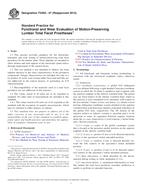
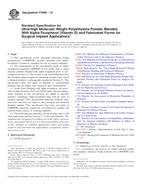 ASTM F2695-12
ASTM F2695-12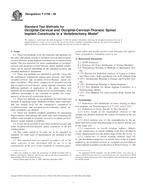 ASTM F2706-08
ASTM F2706-08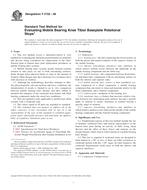 ASTM F2722-08
ASTM F2722-08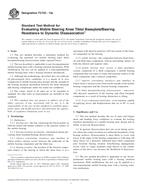 ASTM F2723-13a
ASTM F2723-13a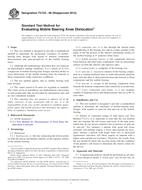 ASTM F2724-08(2014)..
ASTM F2724-08(2014)..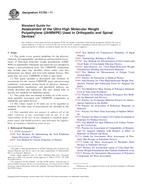 ASTM F2759-11
ASTM F2759-11
 Cookies
Cookies
